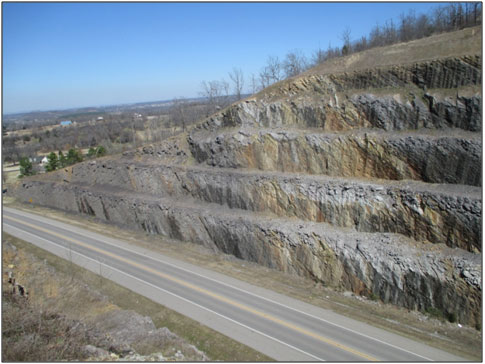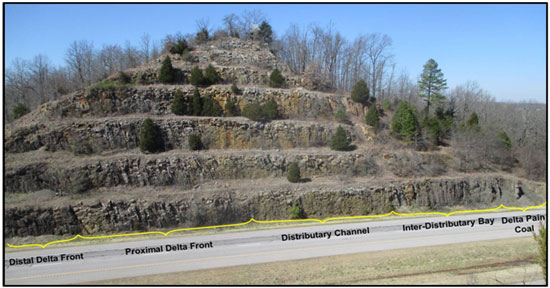The Field Experience
TWO TRIPS – ONE GUIDEBOOK!
Fayetteville is uniquely located in that it offers two notable geologic field experiences. Unfortunately, due to time constraints and to ensure maximum exposure, participants may only attend one field trip. However, be satisfied in knowing that, the conference guidebook will include BOTH trips. The combined guidebook provides an overview of the complete Carboniferous succession exposed in northwest Arkansas. This succession, just like that in the United Kingdom and Western Europe where it was originally defined, consists of a lower, carbonate dominated interval (Mississippian, Trip 1) and an upper, clastic dominated succession (Pennsylvanian, Trip 2). In addition, the combined north to south progression of outcrops is an upward younging progression that records the transition from the Ozark, stable platform into the evolving Arkoma Foreland Basin. Field guides will be conveniently laid out in a self-guided structure so that participants may be able to experience either trip in the future at their own pace.
For both trip, buses will depart promptly from The Chancellor Hotel at 8:00 am on Saturday and return by 5:00 pm. Departure for the field on Sunday will, likewise, be at 8:00 am and return at approximately 12:30 pm. “Grab and go” breakfasts will be provided both mornings, and lunch in the field will be included on Saturday.
Field Trip 1: Lower Mississippian Lithostratigraphy and Depositional Dynamics, Arkansas-Missouri
Led by Dr. Walter Manger
October 1-2, 2016 (20-40 participants)

Lower Mississippian Upper Boone Highstand and Regressive Sequence, with Later Diagenetic and Tripolitic Chert Development, Bella Vista Roadcut, Arkansas
This 1 1/2-day trip will examine selected exposures of the Lower Mississippian succession (lower Kinderhookian through upper Osagean) in roadcuts in Arkansas and Missouri, focusing on the lithostratigraphic succession, sequence stratigraphic history, and depositional dynamics of these carbonates. Attention will also be given to the penecontemporaneous, later diagenetic, and tripolitic chert development in the succession, as well as Waulsortian mound, olistolith occurrences, and the Short Creek Oolite. The goal of the trip is to provide an overview of the carbonate platform to ramp evolution that took place along the south flank of the Laurentian continent prior to significant clastic input that dominated the overlying Pennsylvanian succession (Trip 2).
The Lower Mississippian interval is the thickest post-Ordovician/pre-Atokan succession in the southern Ozarks, comprising a single, third-order Vail cycle. The St. Joe Limestone, and overlying Boone Formation are the lithostratigraphic divisions in northern Arkansas, where they have type areas, but neither name is applied to the coeval, homotaxial limestones in southwestern Missouri. Missouri formation names for the St. Joe interval are recognized in Arkansas as members (ascending order): Bachelor, Compton, Northview, Pierson. The Boone interval in Missouri comprises the (ascending order): Reeds Spring, Elsey, Burlington-Keokuk undifferentiated formations, but these names are not used in Arkansas. Chert development characterizes these units in southern Missouri, but is not used lithostratigraphically. In Arkansas, chert character subdivides the Boone Formation into informal lower and upper members: lower with black to gray, penecontemporaneous chert; upper with white to light gray, later diagenetic chert. The Bachelor Member, St. Joe Limestone, rests unconformably on the Chattanooga Shale (Upper Devonian-Lower Mississippian) or older units marking the initial transgression of the Kaskaskian II Cycle. The Compton thin-bedded, crinozoan packstones were transported from the Burlington Platform down the northern Arkansas ramp, where the succession is condensed and “fines upward.” A brief drop in sea level produced the terrigenous Northview Member, followed by continued transgression through Pierson deposition, reaching maximum flooding without a break in the lower Boone (=Reeds Spring) calcisiltites with penecontemporaneous chert. Highstand and regression are recorded in the upper Boone as the Elsey and Burlington-Keokuk interval, marked by rapidly deposited crinoidal packstones and grainstones with later diagenetic chert. The Short Creek Oolite, type section in Newton County, Kansas, is the only formally named member of the Boone Formation recognized in both Arkansas and Missouri, but occurs sporadically. These ooliths were also transported down-ramp as a grain flow slurry from their origin in shoal areas occupying what is now southwestern Missouri.
Field Trip 2: Morrowan to Desmoinesian Clastics and Basin Evolution
Led by Dr. T.A. “Mac” McGilvery
October 1-2, 2016 (20-40 participants)

Desmoinesian, Hartshorne Fm. documenting a complete deltaic succession, Greenwood Roadcut, Arkansas
The focus of this 1 1/2-day trip is to examine select outcrops of the Pennsylvanian succession (Morrowan through lower Desmoinesian) along the I-49 corridor south of Fayetteville and two localities just south of Ft. Smith. The purpose is to compare the sedimentology and depositional systems that characterized the Ozark Platform with those of the Arkoma Foreland Basin fill. The goal is to develop a better understanding of the tectonic control on accommodation space and sediment supply and its impact on stratigraphic architecture and ultimately reservoir body geometry.
The Morrowan interval records the onset of clastic input across the Ozark Platform. This resulted in a mixed carbonate clastic succession that represents a transitional tectonostratigraphic sequence separating the underlying carbonate dominated succession of the Mississippian (Trip 1) and the overlying clastic dominated Atoka – Desmoinesian interval. These mixed carbonate-clastic units were deposited under shallow marine shelf to near shore settings with the rare preservation of shore zone/tidal flat deposits. The overlying Lower Atokan succession marks cessation of carbonate deposition and the transition to clastic dominated deposition within inner shelf to shore zone systems. The Morrow through Lower Atoka record deposition on a stable, passive margin along the south flank of the Laurentian continent. This platform was broad and low relief, characterized by low accommodation conditions that resulted in rapid and “long distance” shifts in shoreline positions (10’s mi). As a result, the lower Atoka interval is characterized by a series of upward coarsening/thickening cycles 30-100ft in thickness. These result in strike elongate and tabular reservoir bodies in the subsurface. There is a dramatic contrast in the Upper Atoka and Desmoinesian interval. These younger units represent deposition under an entirely different tectonostratigraphic regime. The existing stable platform evolved into a rapidly subsiding foreland basin during the convergence of the Gondwanan continent from the south resulting in the formation of the Pangean super-continent at the end of the Paleozoic. The last two stops represent deposition during the later stages of the Arkoma foreland basin fill. Deposition took place in shore zone/deltaic systems under conditions of rapid subsidence and high sediment supply resulting in significantly different stratigraphic architectures. The upper Atoka is characterized by over thickened tidal flat deposits and the Desmoinesian (Hartshorne Fm.) preserves complete inner shelf/delta front/delta plain successions that are >300ft in thickness. In addition, there is a change in framework grain composition in these younger units marked by an increase in metamorphic rock fragments of phyllite and schist. These are essentially absent in the lower Atoka sandstones. This shift in composition is consistent with sediments derived from the reworked orogenic provenances of the Appalachian Uplift and Ouachita Accretionary Prism. Reservoir bodies in the Hartshorne tend to be dip elongate and concentrated along extended distributary channel complexes.
